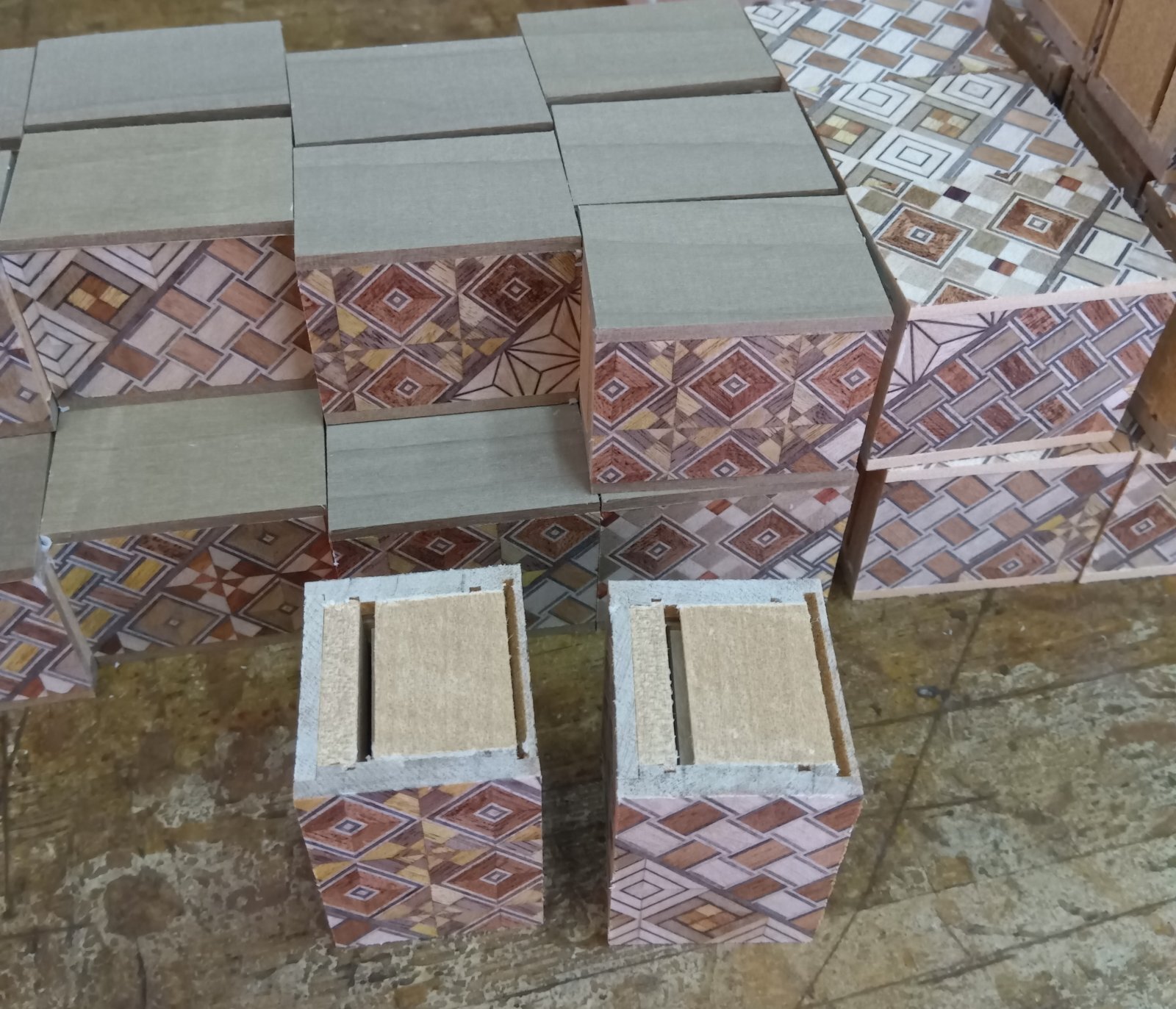Mechanism gap
Today was another record-hot day, so just like yesterday, I did the machine work in the morning and focused on assembly and paneling work in the afternoon. Right now, I am making mame puzzle boxes and 5-sun puzzle boxes. In addition, 3-sun boxes has entered the painting stage.
The photo shows the final assembly process of the mame puzzle box—attaching the Aruki panel (moving panels) side. This one is a 14-steps puzzle box. The panels being attached are only about 2.3 mm thick, so they are very thin. Because of this, when glue is applied to one side, the panel quickly warps. The wood absorbs the moisture from the glue, causing that side to swell. So after applying the glue, the panel must be fixed in place immediately. If the clamp is removed too soon, the panel starts to warp again. That’s why it must stay fixed overnight until the warping is completely settled.
In the photo, you can see a gap of about 1.5 mm between the Aruki panels. This gap is the starting point of the puzzle mechanism—when the Aruki panel moves by that 1.5 mm, it allows the next part of the mechanism to move. Since this is a 14-steps box, the gap is 1.5 mm. But for 18-steps or 22-steps boxes, the gap becomes slightly smaller. The more steps there are, the smaller the movement of each step. Otherwise, the Aruki panels would have to be made thicker, which would either make the whole box larger or reduce the inner storage space.
That’s why I have reduced the movement as much as possible, but I believe 1.2 mm is the practical limit. Of course, it’s possible to make the movement even smaller, but then the sliding action would hardly be felt, and it wouldn’t be very interesting. A puzzle box needs a certain width of movement—without it, the sliding mechanism loses its charm.
Today, I also worked on attaching the yosegi sheets for the boards of 5-sun puzzle box. The panels for the top and bottom had already been made earlier, so this time I only attached the sheets for the sides. Since it’s very hot now, these boards will probably dry quite quickly ☀️🤣
The reason they need to dry is because glue contains a lot of moisture. When I spread the glue across the entire surface of the board and attach the yosegi sheet, the moisture soaks through and even seeps out from the edges. That’s why the boards must be left to dry completely, until all of the moisture is gone from both the board and the yosegi sheet. If not, the side panels will warp later as the moisture escapes.
The photo shows the final assembly process of the mame puzzle box—attaching the Aruki panel (moving panels) side. This one is a 14-steps puzzle box. The panels being attached are only about 2.3 mm thick, so they are very thin. Because of this, when glue is applied to one side, the panel quickly warps. The wood absorbs the moisture from the glue, causing that side to swell. So after applying the glue, the panel must be fixed in place immediately. If the clamp is removed too soon, the panel starts to warp again. That’s why it must stay fixed overnight until the warping is completely settled.
In the photo, you can see a gap of about 1.5 mm between the Aruki panels. This gap is the starting point of the puzzle mechanism—when the Aruki panel moves by that 1.5 mm, it allows the next part of the mechanism to move. Since this is a 14-steps box, the gap is 1.5 mm. But for 18-steps or 22-steps boxes, the gap becomes slightly smaller. The more steps there are, the smaller the movement of each step. Otherwise, the Aruki panels would have to be made thicker, which would either make the whole box larger or reduce the inner storage space.
That’s why I have reduced the movement as much as possible, but I believe 1.2 mm is the practical limit. Of course, it’s possible to make the movement even smaller, but then the sliding action would hardly be felt, and it wouldn’t be very interesting. A puzzle box needs a certain width of movement—without it, the sliding mechanism loses its charm.
Today, I also worked on attaching the yosegi sheets for the boards of 5-sun puzzle box. The panels for the top and bottom had already been made earlier, so this time I only attached the sheets for the sides. Since it’s very hot now, these boards will probably dry quite quickly ☀️🤣
The reason they need to dry is because glue contains a lot of moisture. When I spread the glue across the entire surface of the board and attach the yosegi sheet, the moisture soaks through and even seeps out from the edges. That’s why the boards must be left to dry completely, until all of the moisture is gone from both the board and the yosegi sheet. If not, the side panels will warp later as the moisture escapes.
